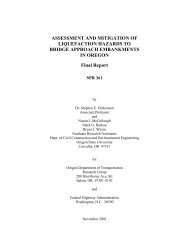Oregon Balance of State HIV/AIDS Housing & Services Systems ...
Oregon Balance of State HIV/AIDS Housing & Services Systems ...
Oregon Balance of State HIV/AIDS Housing & Services Systems ...
You also want an ePaper? Increase the reach of your titles
YUMPU automatically turns print PDFs into web optimized ePapers that Google loves.
44 <strong>Oregon</strong> <strong>HIV</strong>/<strong>AIDS</strong> <strong>Housing</strong> and <strong>Services</strong> <strong>Systems</strong> Integration Plan<br />
Homelessness. However, the <strong>HIV</strong>/<strong>AIDS</strong> housing and services and homelessness systems are not<br />
well-coordinated.<br />
7. Lack <strong>of</strong> Shared Data and Coordinated Planning Between <strong>HIV</strong>/<strong>AIDS</strong> and Homeless<br />
<strong>Systems</strong><br />
Limited data is available on the overlap between the challenges <strong>of</strong> homelessness and <strong>HIV</strong>/<strong>AIDS</strong> in<br />
<strong>Oregon</strong>, and few <strong>HIV</strong>/<strong>AIDS</strong> agencies participate in homeless services or housing planning<br />
processes. Although research shows a strong correlation between <strong>HIV</strong> and housing instability, and<br />
HOPWA has recently required grantees to track homelessness among clients, information systems<br />
are not yet well integrated on the client or systems levels. This makes it difficult for OHOP to<br />
compare data from its epidemiological and programmatic sources against services being used<br />
through homeless services providers. Better data integration would allow OHOP to better document<br />
its resource leveraging and help prevent duplication <strong>of</strong> services for clients served by multiple<br />
systems, and could also prevent some clients from falling through the cracks and not receiving<br />
referrals for needed services.<br />
<strong>Oregon</strong> <strong>Housing</strong> and Community <strong>Services</strong> (OHCS) uses a customized Homeless Management<br />
Information System (HMIS) called OPUS to collect data for its homelessness services and Low<br />
Income Energy Assistance Programs (LIEAP) in the balance <strong>of</strong> state. The OHOP program has not<br />
historically used an HMIS program, but is planning to begin using ServicePoint, the HMIS system<br />
used in the Portland area. Since OHOP does administer an allocation <strong>of</strong> state LIEAP funds, staff are<br />
able to access OPUS for the limited purposes <strong>of</strong> that program, although there is limited funding to<br />
expand OHOP’s use <strong>of</strong> and integration with OPUS at this time.<br />
8. Incomplete Integration <strong>of</strong> <strong>HIV</strong>/<strong>AIDS</strong> Issues into Continua <strong>of</strong> Care<br />
Steering Committee members identified the need to provide better information about people living<br />
with <strong>HIV</strong>/<strong>AIDS</strong> for the sections <strong>of</strong> Continuum <strong>of</strong> Care applications that address subpopulations.<br />
The inclusion <strong>of</strong> this population in Continuum <strong>of</strong> Care planning should also be more meaningful,<br />
and include participation in meetings.<br />
The underutilization <strong>of</strong> Shelter Plus Care (S+C) was another issue noted by the Steering Committee.<br />
There is currently only one Shelter Plus Care project in <strong>Oregon</strong>’s balance <strong>of</strong> state, in the<br />
Eugene/Springfield/Lane County Continuum <strong>of</strong> Care. Some Continua <strong>of</strong> Care in <strong>Oregon</strong> are<br />
reluctant to apply for “bonus” projects (such as S+C projects) beyond pro-rata need, because <strong>of</strong> the<br />
potential burden on sponsor agencies <strong>of</strong> administrative costs and service match requirements. Those<br />
concerns must be addressed in order to ensure that <strong>Oregon</strong>’s communities leverage the maximum <strong>of</strong><br />
Continuum <strong>of</strong> Care funding opportunities. For example, the project in Lane County previously<br />
accepted client referrals from only one provider, but recently has begun working with OHOP to take<br />
referrals to fill unused program slots.<br />
Addictions and Mental Health<br />
9. Addictions and Mental Health <strong>Services</strong> Gap<br />
The Steering Committee saw a significant gap in services for addictions and mental health services<br />
among people living with <strong>HIV</strong>/<strong>AIDS</strong> in <strong>Oregon</strong>’s balance <strong>of</strong> state. <strong>Oregon</strong>’s new competitive<br />
HOPWA Special Project <strong>of</strong> National Significance (SPNS) grant (the <strong>Oregon</strong> <strong>Housing</strong> and<br />
Behavioral Health Initiative, or OHBHI) was recognized as an important source <strong>of</strong> support for<br />
services and an effort to better integrate <strong>HIV</strong>/<strong>AIDS</strong> housing and services with behavioral health

















